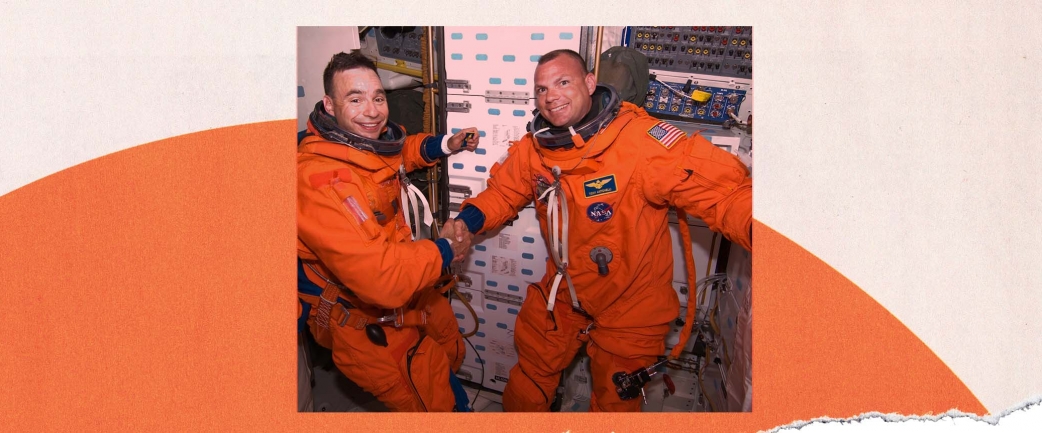
An astronaut’s perspective from two hundred miles up
Howard Kaplan: In space, how do you keep track of time?
Tony Antonelli: On your watch you have all kinds of different times. You’re tracking what time it is on Earth for your family, what time it is on your work schedule for the next thing you have to get done, and what time it is in universal time (Greenwich Mean Time), because your Space Station colleagues’ tasks are planned based on this time. Then, of course, whenever you get a chance to look out the window, it’s day or night on the surface of the Earth somewhere, so you’re tracking that. You’re trying to keep track of a lot of different times. We also have what we call Mission Elapsed Time (MET) on the shuttle: as soon as the shuttle launch begins, you start a clock and it basically counts up from zero.
How does time pass on the Space Shuttle or Space Station?
Both of my missions were on the Space Shuttle. Both went to the Space Station where we did assembly work. These were two-week missions, so the time was very precious. We scheduled events down to five- and fifteen-minute increments. Your entire day for two weeks in a row was critically scheduled. Of course, you practiced all those activities to make sure you could get them done in the time allotted. Also, you gave yourself some buffer.
My first commander was pretty strict with the time. If you finished a task early, the first thing you did was to look to see if any of your crewmates could use a hand making sure all their tasks were completed. But there were big events that folks on the ground had spent a career getting ready for, so you knew they wanted to see it happen and be there. Some of our work was done when it was two or three in the morning in Houston. We were really careful not to get too far ahead of the schedule on the big tasks, because we knew there were other folks depending on us to do it on time, and it was a big part of their participation in the mission as well.
Does gravity play a role?
We don’t get far enough from Earth to be away from the effects of Earth’s gravity. Instead, we fly fast. We’re traveling seventeen thousand, five hundred miles an hour, we’re freefalling, and so it feels like zero gravity. We refer to it as microgravity: very low gravity but not perfectly zero. We fall around the Earth and not back down to the Earth. The weightlessness part is incredibly fun because you can literally fly by pushing off the wall with a fingertip. It’s really cool. It does make all the work more difficult. You never set your pencil down because it will float away.

Is there a difference in how time passes in space as opposed to back on Earth?
On the shuttle, you’re going around the Earth every ninety minutes. Just like on Earth, the days and nights are not the same, except twice a year. Even if you’re not looking out the window you can tell. The sunlight is really bright, and it lights up the flight deck of the Space Shuttle a lot—the Space Station not as much. But on the shuttle you can tell night or day. You realize that the sun is rising and setting every ninety minutes. It becomes more of an emotional reaction. None of the sunrises and sunsets are hidden by clouds. All of them are just beautiful.
Does being in space interrupt your internal clock?
I participated in some sleep studies on both missions. Your body releases melatonin at certain points in the day to tell you when it is time to sleep. That’s based on the color of the light. Direct sunlight and darkness confuse our circadian rhythm. On the Space Station they have installed colored lights, so it cranks up the blue light at the right time of day so that it’s a similar color or wavelength that your body would receive at that time on Earth. NASA tries to make it as comfortable as possible on the Space Station.
What thoughts go through your head when you’re orbiting the Earth?
When you get time to look out the window, the night sky is fantastic, but it’s not dramatically different than the best night sky you’ve seen from Earth. The predominant thought is looking down on Earth and thinking that all of us live here. I don’t know anyone who isn’t from Earth. You probably would have thought I would have known that before the government invested all that time and money in training me. We all live on this planet together, and it’s a pretty small place.
When did space first get on your radar?
Since I can remember I wanted to be an astronaut. I remember being a little kid and thinking I was born too late to get to be the first person to walk on Mars—turns out after all these years I was born too early to do it. I’m still very hopeful that I can help the process and get to see it happen.

Do you think space travel is in everyone’s future?
I do. I just don’t know how long it will take for us to get there. As soon as we can make it affordable, the tourist industry will lead the way. It will be the best vacation that you’ve had to date. I’ll be interested to see how the risk posture evolves as we move into tourism. At Lockheed Martin we’re building for NASA the only exploration class spaceship called Orion. It will allow NASA to take the first steps toward long-duration space flight for Mars missions, examining everything from how you transport food to how artificial intelligence can help monitor and fix systems on board. We’re at the very beginning of extending humanity beyond the moon, but it’s a future we can realize.
What will we need to pack?
Just like any trip here on Earth, it depends on how long you plan to be gone. Some things are obviously required but not that exciting, like air and water. Long explorations—like to Mars and back to Earth—will take a few years, so you’ll want to be very thoughtful and not leave anything critical off your list. But how long could you be away from Earth? If you have the right combination of friends and family with you, you could stay up there a very long time.
About the Contributors
Tony Antonelli is the director of advanced programs for the Commercial Civil Space line of business for Lockheed Martin Space. In this role, he provides leadership for the strategic expansion of Commercial Civil Space programs and capabilities, including innovation and the development of space exploration programs, human space flight, weather satellites, and launch systems. He is a retired Navy captain and former NASA astronaut who has accumulated over 4,700 flight hours in over forty different kinds of aircraft and served as the pilot for two Space Shuttle missions: STS-119 and STS-132.
Howard Kaplan is the former editor in chief of Asiatica, the annual magazine of the Freer and Sackler Galleries, Smithsonian Institution. For his writing he has received fellowships from the MacDowell Colony, the Bread Loaf Writers’ Conference, and the Edward Albee Foundation among others. He currently divides his time between New York and Washington, DC.





